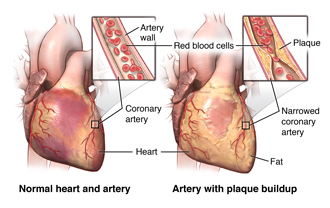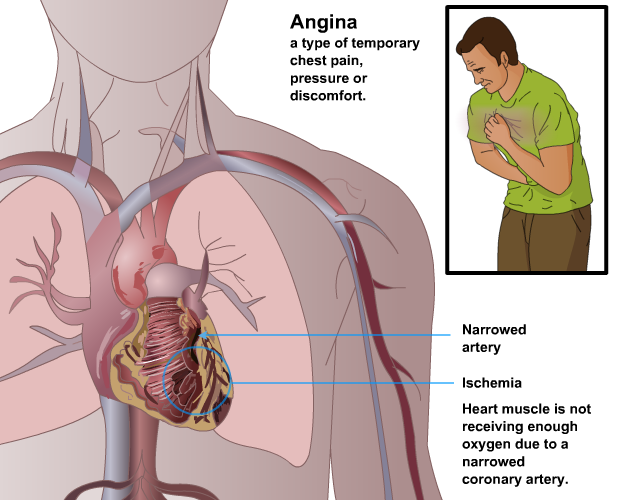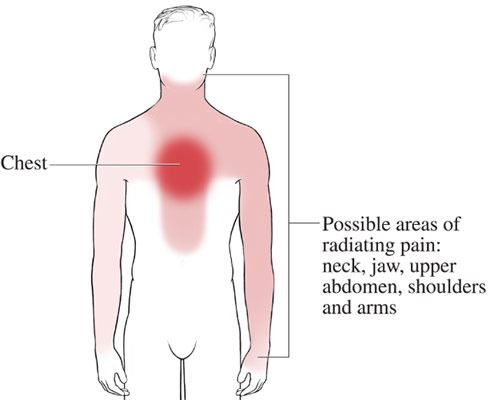This usually happens because one or more of the hearts arteries is narrowed or blocked also called ischemia. It happens when some part of your heart doesnt get enough blood and oxygen.

Angina Pectoris Johns Hopkins Medicine
The diagnosis angina pectoris is a symptom diagnosis.

. Rarely is the pain described as severe. Angina can be described as a discomfort heaviness pressure aching burning fullness squeezing or painful. The truth is that exactly the same symptoms can be the results of pathological changes in for example the oesophagus.
It is a common presenting symptom typically chest. Typically the pain is described as a crushing or constricting pain. Ad Learn How to Understand the Common Risk Factors and How to Identify Signs of Angina.
This occurs when arteries that carry blood to your heart become narrowed and blocked because of atherosclerosis or a blood clot. Other causes include anemia abnormal heart rhythms and heart failure. Angina also called angina pectoris can be a recurring problem or a sudden acute health concern.
Find More on Heart Health From AARP. The sensation is typically described as substernal chest pressure or tightness often accompanied by shortness of breath and often radiates to the jaw neck and left arm or. The word angina comes from the Latin word angere meaning to choke or strangle To doctors angina almost always means angina pectoris or chest pain due to an inadequate supply of oxygen to the heart muscle pectoris refers to the chest.
This is the network of arteries that nourish the heart muscle. Comparing Heberden with common practice in modern times it seems to be the other way around now because his masterly description of angina pectoris has been stripped to its bare minimum chest and pain thus eroding the significance of proper history-taking and turning a diagnostic tool such as exercise electrocardiography into a method of screening. Angina is relatively common but can be hard to distinguish from other types of chest pain such as the pain or discomfort of indigestion.
Due to the insufficient blood flow to the heart heart cells are starved of oxygen and begin to die. Angina pectorisor simply anginais chest pain or discomfort that keeps coming back. It is an extremely common symptom of coronary artery disease which is caused by cholesterol-clogged coronary arteries.
It occurs when the heart muscle doesnt get as much blood as it needs. Angina pectoris is the result of myocardial ischemia caused by an imbalance between myocardial blood supply and oxygen demand. The usual site of pain in angina is the chest but may also be felt in the shoulders arms neck throat jaw or back.
Discover the Secrets to a Healthy Heart. A common presentation as told by most patients is the feeling that someone is standing on their chest. The pathogenic factors are qi deficiency blood stasis and stagnation and phlegm stasis.
But the neck jaw shoulders and even the arm may also hurt during an angina attack. Whilst certain descriptive terms have been identified as describing angina and not other causes of chest pain these terms have not been systematically evaluated among local Malaysian patients. Description of the chest pain of angina pectoris by patients is commonly used in the diagnosis evaluation and monitoring of ischaemic heart disease.
The common medical assumption is that these symptoms are caused by decreased circulation in the coronary vessels. Angina Pectoris is a medical term for chest discomfort or pain as a result of coronary heart disease. The complication to avoid is the fatal separation of yin and yang.
The pain in angina pectoris is typically felt behind the breastbone retrosternal and sometimes may be more pronounced slightly to the left of the sternum. It is often called discomfort not pain. However even pain on the right of the sternum can also be due due to angina.
Angina is usually due to obstruction or spasm of the arteries that supply blood to the heart muscle. Angina can be a symptom of coronary artery disease CAD. Angina Pectoris Angina Perctoris is a symptom that is felt as pain in the chest.
Angina angina pectoris describes the pain discomfort ache or other associated symptoms that occur when blood flow to heart muscle cells is not enough to meet its energy needs. Angina pronounced ANN-juh-nuh or ann-JIE-nuh is pain in the chest that comes on with exercise stress or other things that make the heart work harder. The pain associated with angina is typically described as squeezing pressure heaviness tightness or pain in your chest.
Angina pectoris is the medical term for chest pain or discomfort due to coronary heart disease. The most common symptom of heart disease is angina or angina pectoris or simply chest pain. The pain of angina is usually mild or moderate in severity.
The pain conducting systems in the thorax will be described. Angina is a condition characterized by chest pain sometimes severe that is caused by an inadequate blood supply to the heart. The clients often says the pain feels like gas heart burn or indigestion.
A condition marked by severe pain in the chest often also spreading to the shoulders arms and neck owing to an inadequate blood supply to the heart. Angina also known as angina pectoris is chest pain or pressure a symptom of coronary heart disease usually due to insufficient blood flow to the heart muscle myocardium. Angina pectoris is classified under xiong bi chest obstruction and heartache and involves various disharmonies between the heart liver kidney and spleen.
The pain of this symptom is often described as intense pressure or squeezing in the chest. This symptom is likely to occur when the arteries arent supplying the heart with enough blood blockage occurs so does the oxygen-rich blood flow from supplying the heart. Up to 10 cash back Angina pectoris is the classic manifestation of cardiac ischemia which occurs when there is a mismatch between myocardial oxygen supply and demand.
Angina is typically described as squeezing pressure heaviness tightness or pain in your chest. Clients describe the pain of angina as squeezing burning pressing choking aching or bursting pressure. It occurs when the heart does not receive sufficient blood most probably due to one or more arteries of the heart getting blocked.



0 Comments